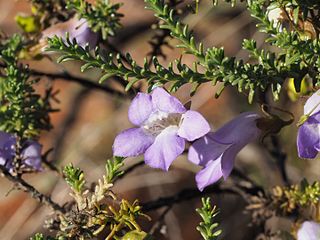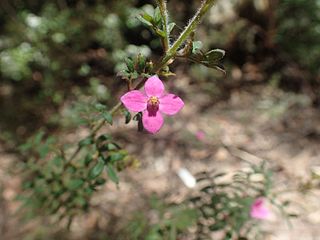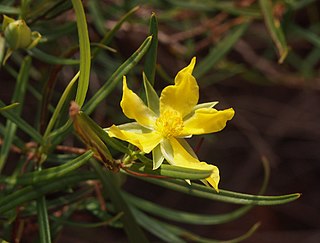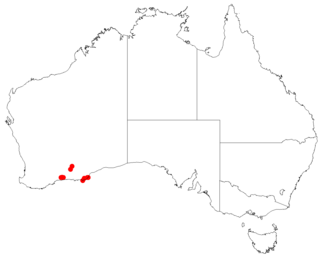
Eremophila clarkei, commonly known as turpentine bush, is a flowering plant in the figwort family, Scrophulariaceae and is endemic to Western Australia, South Australia and the Northern Territory. It is a shrub which is variable in form, but usually with narrow leaves and white or pale pink flowers. It is similar to Eremophila georgei and Eremophila granitica.

Prostanthera walteri, commonly known as blotchy mint-bush, is a species of flowering plant that is endemic to south-eastern Australia. It is a sprawling shrub with tangled, hairy branches, egg-shaped leaves and usually bluish green flowers with prominent purple veins arranged singly in leaf axils.

Eremophila hughesii is a flowering plant in the figwort family, Scrophulariaceae and is endemic to Australia. It is spindly, glabrous shrub with narrow leaves and with flowers that vary in colour from blue to pink, sometimes white. It is native to Western Australia and the Northern Territory.
Stenocarpus acacioides is a species of flowering plant in the family Proteaceae and is endemic to north-western Australia. It is a shrub or tree with elliptic leaves and groups of white flowers and woody, linear follicles.

Eremophila densifolia is a flowering plant in the figwort family, Scrophulariaceae and is endemic to the south-west of Western Australia. It is usually a low, spreading shrub with densely clustered leaves and lilac to purple flowers.

Eremophila drummondii, commonly known as Drummond's eremophila, is a flowering plant in the figwort family, Scrophulariaceae and is endemic to the south-west of Western Australia. It is a variable shrub, usually with sticky branches and leaves, long, thin leaves and mauve or purple flowers in spring.

Eremophila exilifolia is a flowering plant in the figwort family, Scrophulariaceae and is endemic to Western Australia. It is a widely distributed shrub which is shaped like an inverted cone and has small, very sticky leaves and branches and lilac-coloured flowers.

Eremophila psilocalyx is a flowering plant in the figwort family, Scrophulariaceae and is endemic to Western Australia. It is an erect shrub with a broom-like shape, narrow, hooked leaves and white, pink, blue or purple flowers. It is common in the mallee country around Esperance. It was sometimes incorrectly known as Eremophila pachyphylla.

Grevillea disjuncta is a species of flowering plant in the family Proteaceae and is endemic to the south-west of Western Australia. It is low, mounded or spreading shrub with linear to more or less needle-shaped leaves and small groups of pale orange to bright red and green or yellow flowers.

Grevillea oligantha is a species of flowering plant in the family Proteaceae and is endemic to southern Western Australia. It is dense shrub with many erect branches, egg-shaped, lance-shaped or linear leaves, and groups of up to six brownish-yellow, orange or reddish-brown flowers with a pale yellow to reddish style.

Pityrodia chrysocalyx is a flowering plant in the mint family Lamiaceae and is endemic to the south-west of Western Australia. It is an erect, bushy shrub with small, glossy leaves, and flowers with white petals and a golden-yellow calyx.

Boronia filifolia, commonly known as the slender boronia, is a plant in the citrus family Rutaceae and is endemic to south-eastern Australia. It is a slender shrub with simple or pinnate leaves and pale to deep pink four-petalled flowers.

Boronia gracilipes, commonly known as karri boronia, is a plant in the citrus family, Rutaceae and is endemic to the south-west of Western Australia. It is an erect, spindly shrub with compound leaves and pink, four-petalled flowers.

Boronia heterophylla, commonly known as red boronia or Kalgan boronia, is a plant in the citrus family Rutaceae, and is endemic to the south-west of Western Australia. It is an erect, slender shrub with trifoliate leaves and deep pink to red, four-petalled flowers arranged singly in leaf axils.

Cyanothamnus bussellianus is a plant in the citrus family, Rutaceae and is endemic to the south-west of Western Australia. It is a slender perennial herb or shrub with well-spaced, simple leaves and pink, blue or white, four-petalled flowers.

Cyanothamnus defoliatus is a plant in the citrus family, Rutaceae and is endemic to the south-west of Western Australia. It is a straggly shrub with simple, thread-like leaves and white to pink, four-petalled flowers that are pale blue on the back.

Prostanthera canaliculata is a species of flowering plant in the family Lamiaceae and is endemic to the south-west of Western Australia. It is a small, erect shrub with hairy branchlets, narrow egg-shaped to narrow elliptical leaves and pale blue or pale violet to white flowers with no markings.

Hibbertia glaberrima is a species of flowering plant in the family Dilleniaceae and is endemic to Central Australia. It is a glabrous, spreading shrub with oblong to lance-shaped leaves and yellow flowers borne singly in upper leaf axils, with 30 to 150 stamens arranged around three carpels.

Leucopogon bossiaea is a species of flowering plant in the heath family Ericaceae and is endemic to a restricted area in the south-west of Western Australia. It is an erect shrub with elliptic to broadly egg-shaped leaves and white flowers in four to eleven upper leaf axils.

Leucopogon breviflorus is a species of flowering plant in the heath family Ericaceae and is endemic to the south-west of Western Australia. It is an erect, spindly, glabrous shrub that typically grows to a height of up to about 1.5 m. It has oblong to lance-shaped or linear leaves 4–9 mm (0.16–0.35 in) long on a short petiole and with a small, rigid point on the tip. The flowers are borne singly or in pairs in leaf axils on a short peduncle with small bracts and bracteoles about half as long as the sepals. The sepals are about 2 mm (0.079 in) long and the petals white and about 4 mm (0.16 in) long, the petal lobes longer than the petal tube.




















